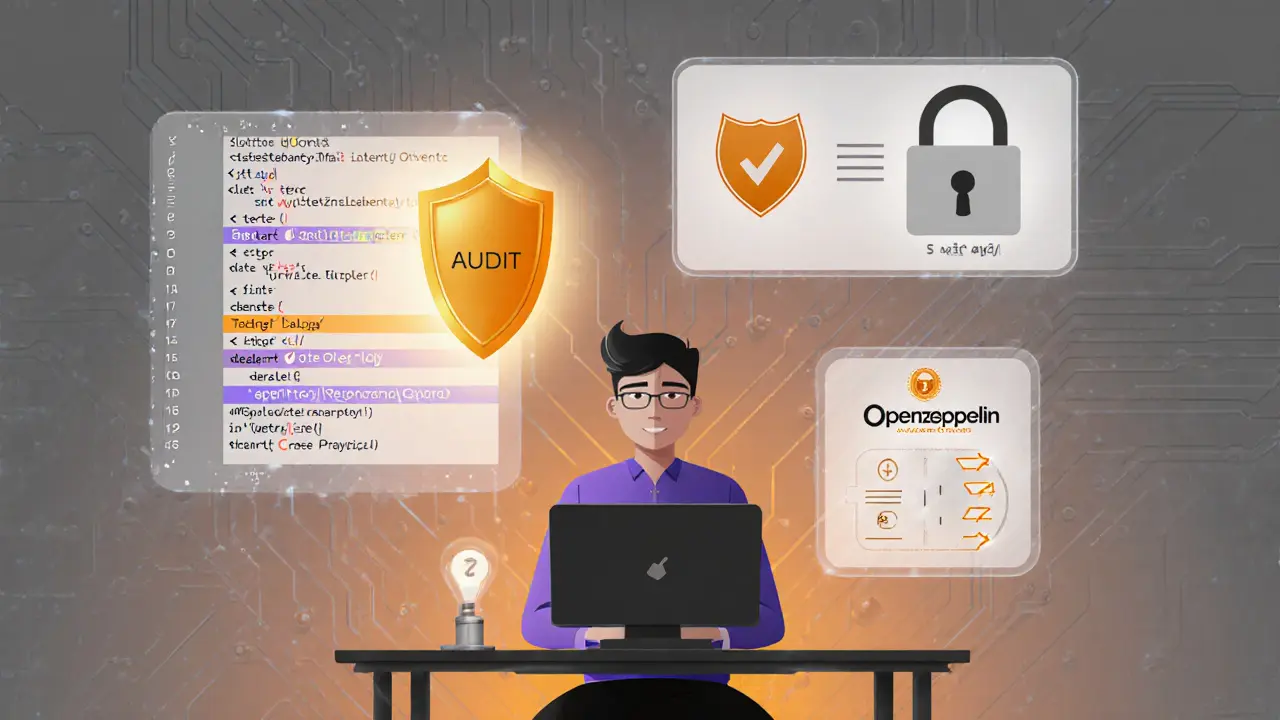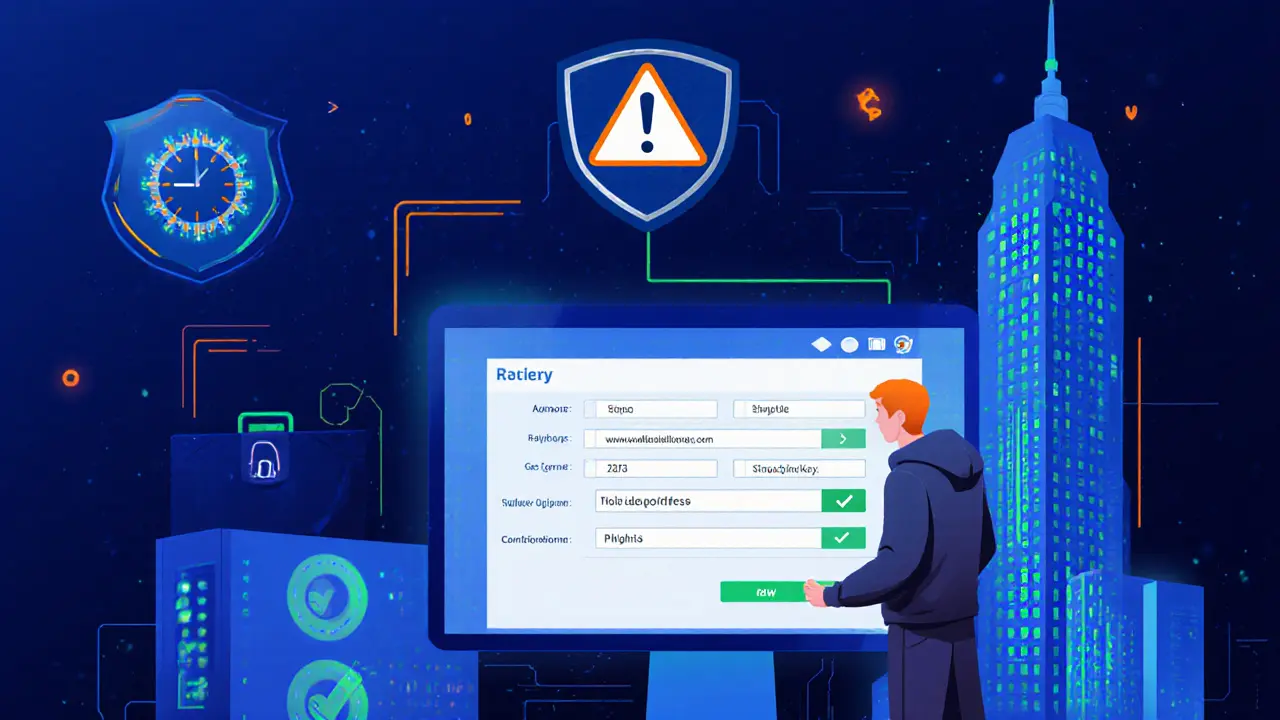dApp Security Checklist
This interactive checklist helps you identify critical security aspects of your dApp. Click on each item to learn more about its implementation.
Smart Contracts Critical
Review for reentrancy, overflow, access control, and external calls.
Wallet Integration High
Ensure secure connection and transaction preview features.
Access Control Medium
Implement role-based access control across all layers.
Governance Medium
Secure DAO upgrades and decision-making processes.
Privacy Low
Use ZK-proofs and DID frameworks for selective disclosure.
Infrastructure High
Store keys securely in HSMs and enforce backups.
Smart Contracts
Start with the OWASP Smart Contract Security Verification Standard (SCSVS). Use formal verification or reputable audit firms to catch reentrancy, overflow, and access-control bugs. Apply the Checks-Effects-Interactions pattern to prevent reentrancy attacks and compile with Solidity 0.8+ for built-in overflow checks.
dApp is a decentralized application that runs on blockchain networks, typically using smart contracts to automate logic. Because the code lives on an immutable ledger, any flaw can be exploited forever. Understanding dApp security means looking at the whole stack - from the contract code to the user‑facing web interface, wallet integration, and the governance model that controls upgrades.
Quick Takeaways
- Start with the OWASP Smart Contract Security Verification Standard (SCSVS) for a baseline checklist.
- Use formal verification or reputable audit firms to catch reentrancy, overflow, and access‑control bugs.
- Secure wallet connections with libraries that validate contract addresses and display transaction details.
- Apply role‑based access control (RBAC) at both contract and UI layers.
- Educate users on phishing, fake dApp sites, and the importance of hardware wallets.
Understanding the dApp Architecture
A typical dApp has four layers:
- Network layer - the blockchain (Ethereum, Solana, etc.) that provides consensus.
- Smart contract layer - self‑executing code that encodes business rules.
- Backend/off‑chain services - optional APIs, storage (IPFS, Arweave), oracles.
- Frontend - the Web3 UI that talks to wallets and displays data.
Each layer brings its own attack surface. Securing the network itself is mostly out of a developer’s hands, but you can choose chains with robust validator sets and well‑audited client software. The smart contract layer is where most high‑profile hacks happen, so it deserves the deepest scrutiny.
Smart Contract Security Essentials
Smart Contract is a program that runs on a blockchain and enforces rules without a central authority. Applying the OWASP SCSVS checklist helps cover the most common weaknesses:
- Reentrancy protection: use the Checks‑Effects‑Interactions pattern or the OpenZeppelin
ReentrancyGuardmodifier. - Arithmetic safety: compile with Solidity 0.8+ which has built‑in overflow checks, or use
SafeMathlibraries for older versions. - Access control: implement
onlyOwneror role‑based modifiers; never rely ontx.origin. - External calls: limit the amount of gas forwarded and validate return values.
- Randomness: avoid on‑chain pseudo‑randomness; use verifiable randomness services (VRF).
Formal verification tools like Certora or MythX can mathematically prove that a contract adheres to its specification, but they complement-don’t replace-manual code reviews and third‑party audits.
Front‑End and Wallet Integration
The UI is the bridge between users and the blockchain, so it must guard against social‑engineering attacks.
Web3 Wallet is a cryptographic key manager that signs transactions on behalf of the user. Follow these practices:
- Validate that the contract address displayed matches the verified source code on a block explorer.
- Show a full transaction preview - token amounts, gas fees, and a link to the contract’s source.
- Require multi‑step confirmations for high‑value actions (e.g., NFT transfers, DAO votes).
- Use reputable libraries like Ethers.js or web3.js that are actively maintained.
For DEXs and NFT marketplaces, always include a “Verify Contract” button that opens Etherscan or similar, letting users double‑check the address.

Decentralization, Governance, and Custody
How much control the developers retain directly impacts security posture.
Decentralized Autonomous Organization (DAO) is a member‑run entity that makes decisions through on‑chain voting. When a dApp relies on a DAO:
- Ensure quorum and timelock parameters prevent rushed malicious upgrades.
- Audit the DAO’s governance contracts for voting manipulation (e.g., flash‑loan attacks).
Hybrid models often keep a “circuit breaker” key in a hardware security module (HSM) to stop an emergency upgrade. Hardware Security Module is a tamper‑resistant device that stores cryptographic keys and can perform signing operations. Using an HSM with threshold signatures adds a geographic dispersal of trust.
Common Attack Vectors and Real‑World Cases
- Phishing sites: fake Uniswap clones trick users into approving malicious contracts. Counter: educate users to check URL, use bookmark, and verify contract address.
- Rug pulls: developers withdraw all liquidity after a token’s launch. Mitigation: lock liquidity via third‑party contracts and display lock proof.
- Reentrancy exploits: the 2016 DAO hack stole $60M. Use the pattern mentioned earlier and run static analysis.
- Oracle manipulation: price feeds can be spoofed, leading to liquidations. Use decentralized oracle networks with multiple data sources.
Privacy and Identity Management
Even though blockchain data is public, users often need selective disclosure.
Zero‑Knowledge Proof (ZKP) is a cryptographic method that proves a statement true without revealing underlying data. ZK‑Rollups and ZK‑SNARKs let users prove balance sufficiency without exposing the exact amount.
Decentralized identity (DID) frameworks provide verifiable credentials that users can present on demand. Integrating a protocol like Gateway Protocol lets a dApp request only the data it truly needs, keeping the rest private.
Implementation Checklist
| Area | Key Action | Tool / Standard |
|---|---|---|
| Smart contracts | Run static analysis, formal verification, third‑party audit | MythX, Certora, OWASP SCSVS |
| Wallet UI | Display verified contract address, full transaction preview | Ethers.js, MetaMask SDK |
| Access control | Implement RBAC, review privileged roles quarterly | OpenZeppelin AccessControl |
| Governance | Set timelocks, multi‑sig upgrade process | Gnosis Safe, DAOstack |
| Privacy | Use ZK‑Proofs for sensitive checks, enable DID | zkSNARK, DID‑Auth |
| Infrastructure | Store keys in HSM, enforce multi‑region backups | YubiHSM, Threshold signature schemes |
Follow the list before launch and repeat it after every major update.
Next Steps for Developers
- Integrate the OWASP SCSVS into your CI pipeline; treat failures as build blockers.
- Run a bounty program on platforms like Immunefi to crowdsource additional testing.
- Publish a clear security policy and contact address so researchers can report bugs responsibly.
- Provide users with a security guide covering wallet safety, phishing avoidance, and the benefits of hardware wallets.

Frequently Asked Questions
What is the OWASP Smart Contract Security Verification Standard?
The OWASP SCSVS is an open‑source checklist that guides developers through design, coding, testing, and deployment phases of smart contracts. It covers reentrancy, arithmetic safety, access control, and more, providing a common language for auditors and auditors alike.
How do I verify that a contract address shown in a dApp is legit?
Display the address alongside a link to a block explorer where the source code is verified. Encourage users to compare the address with the one posted on the official project site or social channels.
Are hardware wallets enough to prevent phishing?
Hardware wallets protect private keys from malware, but they can’t stop a user from signing a malicious transaction. Always verify transaction details on‑screen and use wallet software that highlights contract interactions.
What role do zero‑knowledge proofs play in dApp privacy?
ZK‑Proofs let a user prove they meet a condition-like owning enough tokens-without revealing the exact balance. This enables confidential transactions and privacy‑preserving DeFi protocols.
How frequently should a dApp undergo a security audit?
At minimum, audit every major version or after any substantial change to the contract logic. Many teams also run a post‑deployment audit for live contracts and schedule annual re‑assessments.


20 Responses
The shadows whisper that every unchecked line is a backdoor to the abyss.
Great rundown! I especially like the emphasis on formal verification – it’s like a safety net for code that can’t be patched once deployed.
Also, reminding users about phishing is a nice human touch.
Nice checklist, but you could throw in a line about test‑net deployments before mainnet launch.
That usually catches a lot of goofy bugs early.
I’d add that governance contracts should be audited separately from the core logic – they often have different threat models.
Also, consider multi‑sig timelocks for any upgrade path.
It’s a cheap insurance policy.
Finally, keep your documentation versioned alongside the code.
Loving the proactive vibe here!
Just remember to keep the user guide simple and visual – screenshots of the wallet prompt go a long way.
This is fire! The hardware‑security‑module tip is pure gold.
Combine it with threshold signatures and you’ve got a fortress.
Don’t forget to rotate keys periodically – complacency is the enemy.
Also, backup your HSM configs in encrypted form across regions.
Overall, superb checklist.
Wow!!! This checklist covers EVERYTHING!!!
From re‑entrancy to zero‑knowledge proofs – it’s like a Swiss‑army knife for dApp security!!!
Look, if you aren’t locking liquidity on a reputable third‑party contract, you might as well hand your users a sack of sand.
Show the lock proof loud and clear – transparency builds trust.
And stop ignoring the social‑engineering attack surface; phishing is the low‑hangman’s noose.
Honestly, the OWASP SCSVS is just the starting line, not the finish.
Every smart contract should also be fuzz‑tested with tools like Echidna to hunt edge‑case bugs.
And never trust a single audit; multiple eyes catch more.
While the checklist is thorough, I must point out that relying solely on formal verification can give a false sense of security.
Even mathematically proven contracts can be vulnerable to off‑chain attacks, such as compromised private keys.
Therefore, a layered defense strategy, including runtime monitoring, is indispensable.
Sup folks, this is a solid starting point.
Just remember to keep the UI updates in sync with any contract changes.
Congrats on the checklist, now go audit something that actually matters.
Nice work! Just a tip – make sure you add a section on contract upgradability patterns, like UUPS, to keep things smooth.
Also, double‑check spelling of “deployment”.
When we dissect the security posture of a decentralized application, it becomes evident that the attack surface is not monolithic but rather a composite of interdependent strata, each demanding its own rigorous scrutiny. The foundational stratum originates at the protocol layer, where consensus mechanisms and validator economics dictate the baseline resilience against chain‑level adversarial actions. Ascending to the smart‑contract layer, one encounters deterministic execution semantics that, while immutable post‑deployment, are susceptible to logical flaws such as re‑entrancy, unchecked external calls, and arithmetic overflows; mitigation strategies here involve the adoption of the Checks‑Effects‑Interactions paradigm, the utilization of Solidity 0.8+ intrinsic overflow checks, and the integration of static analysis suites like MythX or Slither. The off‑chain services stratum introduces oracle dependencies, bridging mechanisms, and data availability concerns; employing decentralized oracle networks such as Chainlink, with multi‑source aggregation and timelocked data feeds, curtails the risk of price manipulation. The user‑interface tier, often overlooked, serves as the primary vector for social engineering; enforcing contract address verification badges, transaction preview dialogs, and multi‑step confirmation flows dramatically reduces phishing success rates. Moreover, the governance framework constitutes a meta‑layer of security, wherein DAO timelocks, quorum thresholds, and role‑based permissioning must be codified in immutable policies, possibly safeguarded by hardware security modules (HSMs) that house the ultimate upgrade keys. From a cryptographic standpoint, zero‑knowledge proofs (ZK‑SNARKs, ZK‑STARKs) furnish confidentiality without compromising auditability, enabling privacy‑preserving transactions that still satisfy compliance mandates. Decentralized identity (DID) solutions further augment this paradigm by allowing selective disclosure of credentials, mitigating the risk of data leakage. Finally, operational security practices-such as rotating HSM keys, enforcing multi‑region backups, and instituting continuous monitoring via on‑chain analytics platforms-ensure that any emergent threat vectors are detected and remediated in near real‑time. In sum, a holistic security methodology, coupling formal verification, rigorous operational controls, and user‑centric design, is indispensable for robust dApp resilience in the evolving blockchain ecosystem.
Building on that comprehensive analysis, it’s crucial to emphasize the importance of iterative security post‑deployment. Even after exhaustive pre‑launch audits, the dynamic nature of the blockchain ecosystem introduces novel exploits-consider the emergence of sandwich attacks, flash‑loan vectors, and cross‑chain replay attacks that were not prevalent a year ago. Therefore, establishing a continuous integration pipeline that incorporates automated fuzz testing, property‑based testing, and regression analysis is paramount. Additionally, a bounty program on platforms such as Immunefi not only crowdsources vulnerability discovery but also signals to the community a proactive stance on security. Transparent disclosure policies and a well‑defined responsible disclosure process foster trust and accelerate remediation timelines. On the governance front, periodic review cycles for role assignments and timelock parameters ensure that privilege creep does not erode the system’s integrity. Finally, educating end‑users through in‑app tutorials, phishing awareness campaigns, and encouraging hardware wallet adoption creates a human layer of defense that complements technical safeguards. By integrating these operational practices with the technical checklist, developers can maintain a robust security posture that adapts to emerging threats.
Honestly, this checklist is kinda basic. 🤔
If you really wanted to impress, you’d talk about composable DeFi security patterns and meta‑governance audits. 🙄
Solid list – concise and to the point.
Sure, but why does every guide keep treating dApps like they’re all the same? Different chains have wildly different threat models; a one‑size‑fits‑all checklist is a myth.
I think the checklist covers the basics well. It could use a bit more depth on oracle security.
While the checklist is thorough, let us not forget that a truly secure dApp must also cultivate a culture of vigilance among its community. 😊
Regular security webinars and transparent incident reports reinforce trust.
Finally, always keep a contingency plan ready – you never know when the next exploit will surface.